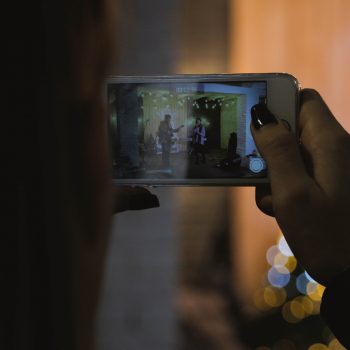How to shoot great video on your smartphone
 Video is all the rage when it comes to producing content for social media and websites these days. If that has you thinking you need to go out and spend $3,000 for equipment and editing software, you might first consider using the smartphone in your pocket to get started instead.
Video is all the rage when it comes to producing content for social media and websites these days. If that has you thinking you need to go out and spend $3,000 for equipment and editing software, you might first consider using the smartphone in your pocket to get started instead.
I’m not saying to not get that camcorder or DSLR, tripod and lighting equipment. I am suggesting to first learn how to use the equipment you have before investing in something better. Why? Because more often than not, bad video isn’t bad because of equipment limitations, it’s bad because of technique.
With the camera technology built into today’s smartphones, you can shoot fairly high-quality videos with your phone. You just have to use proper technique.
Here are some tips to make your smartphone video better, so that when you buy that DSLR, your video will be amazing.
Clean your lens
Before hitting the record button on your smartphone, wipe your lens. It could be oil from your thumbprint or dust from taking pictures at your son’s T-ball game, but all the same, it will make your image cloudy. Think of cleaning your lens like taking the cap off a camera.
Shoot in landscape format
While it’s easier to hold a phone vertically and you may be accustomed to taking your selfies in the portrait (vertical) orientation, remember that you — and everyone else — are used to viewing movies in the landscape orientation. If you want your video to look professional, “Do thou likewise” and shoot your video in landscape. If you are shooting for SnapChat or Instagram, shooting vertical is okay, but for everything else, landscape is best.
Compose your shot
As you are figuring out your scene, look at it through your phone’s screen and ask yourself if the shot would look good as a picture. If it won’t look good as a picture, it will not work for video either. Recompose and make that scene something you could see framed and on a wall.
In doing this, a good help is the rule of thirds. With your mind, divide your scene into thirds, both vertically and horizontally. You want to place your subject into one of the four intersections of those lines. Typically, if you are shooting an interview, for example, you’ll want your subject not in the center but in line with the left or right vertical lines. Doing so creates a slight imbalance and creates interest in the scene. If you have a horizon in your scene, place the horizon in the top third of the scene. A tree? On the left or right third of the scene.
Keep it steady
You don’t want your viewer to get seasick watching your video. For this reason, when shooting scenes, if you don’t have a tripod to use, be a tripod. Hold your phone still. If you are needing to follow motion, do so, but go with the direction of the motion and keep it smooth and steady.
Shoot wide and tight
Unless you’re following motion, don’t pan a scene. If you think about how you look around with your own eyes, you tend to capture the larger scene before looking more intently at the details in the scene. You see a crowd, then you see a face in the crowd. You don’t pan. You see, you just did a wide shot and then a tight shot with your mind. That’s what you want to do with your video.
When shooting a sequence of scenes, shoot wide establishing shots, then walk in closer for your tighter shot. Don’t use digital zoom on your phone (as the quality degrades), but you can use optical zoom if your phone is equipped. If not, walk in closer and get the shot.
Another great use for the tight shots is to use them for transitions when editing. You never want to go from a wide shot of one scene to a wide shot of another scene as this tends to be jarring visually. Get your wide shot, then your tight shot within that scene, then shoot the wide of your next scene.
Shoot and repeat
Perhaps the greatest aspect of video that sets it apart from photography is motion. Use that quality. Use that motion to make your video interesting.
If you were taking video of Ree Drummond (The Pioneer Woman) decorating a cake, you would see her repeat the motion of stirring the bowl of icing, dipping the spatula into the bowl and then applying the icing to the cake many times. Use this opportunity to do a wide shot of her stirring the icing, then a tight of the spatula sliding through the creamy icing or her hand on the spatula. Or get a wide shot of her icing the cake then tighten the shot again to capture the spatula slipping over the surface of the cake.
Shoot the same action again, wide and tight, but from different angles. In editing, you can then make the motion look continuous as you go from wide to tight, but do it while the spatula is in motion. The effect will look really slick, as if you had multiple cameras working. It’ll add a flare to your video.
Experiment and have fun
Have fun! Try shooting from low or high angles and show people what they normally wouldn’t see. You don’t have to shoot all the time from eye-level height. Shooting lots of foot traffic? Do your establishing wide shot of people walking on the sidewalk, but don’t be afraid to get on the pavement (out of the way of traffic), put the phone down with the lens next to the ground, get tight and show the tread of those shoes as they hit the pavement. Or jump up on a bench and shoot down at the crowd. See a reflection of passing people on the bumper of parked classic car? Capture that! Have fun!
If you follow these tips when capturing video with your smartphone, you’ll soon have the groundwork to make superfine videos with more expensive equipment and may have a better idea of what you are looking for before you spend the big bucks.
Good luck and happy videoing!

Thomas Berger is a communications and digital marketing specialist. Prior to striking out on his own, he was the communications coordinator at R.K. Black, Inc., an Oklahoma City-based technology company, where for more than four years he was been a one-man team of digital marketing, internal and external communications and social media specialists.
Prior to R.K. Black, he worked for ten years as a journalist, starting out as a staff writer for two newspapers in North Carolina, then working for three papers in northeastern Oklahoma and finally finishing his journalism career as a multimedia journalist for KJRH Channel 2 in Tulsa. There he reported for and ran a hyper-local news website, BartlesvilleLIVE.com, before being transferred to covering news in Tulsa’s surrounding areas for the television station’s online “Community” news section.
Born in the Netherlands and having lived in multiple countries and a number of states, Thomas moved from North Carolina to Oklahoma eight years ago, where he met his wife and now lives in her hometown of Edmond. He holds a Bachelor of Arts in English with a journalism concentration from Western Carolina University where he also minored in photography. He currently serves on the board of the International Association of Business Communicators (IABC) Central Oklahoma chapter as the VP Professional Development after serving for two years as the VP Communications.
In his spare time, Thomas enjoys photography, writing, hiking, backpacking, camping, traveling, learning languages, gardening and being a handyman.